Snowshoe Basics
By Karen Berger
Photographs by John R. Fulton Jr.
Don't let a blanket of white keep you from hiking through a winter wonderland.
It's cold, it's winter, and there is two feet of snow covering the ground, but that's no reason to stay indoors. Strap on a pair of snowshoes, and you can stride out into the backcountry no matter what Mother Nature has in store.
Snowshoeing has become enormously popular in recent years. It's inexpensive, it's terrific exercise, and it's easy to do. If you can walk, you can snowshoe. Beginners can master basic skills in a few minutes.
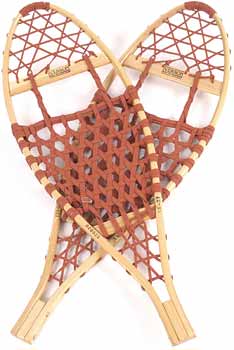 Iverson's Modified Bearpaw is a white ash frame snowshoe available with either neoprene or rawhide lacings. The 12-inch-by-35-inch model supports 200 pounds. |
Choosing a snowshoe
Snowshoes vary in shape and size from long and lean to short and stubby, depending on a person's weight and what type of snow they will travel on.
First, determine how much "float" you need. Float measures a snowshoe's effectiveness at keeping you on top of the snow. The heavier you (and your pack) are, the more float you'll need, and usually a bigger snowshoe.
Snow conditions matter, too. On fluffy dry powder, you need more float than on the wetter, hard-packed stuff. While all snowshoe manufacturers state the maximum weight a snowshoe is designed to carry, only some specify whether this applies to powder or hard-packed snow. If the manufacturer doesn't rate a snowshoe for the type of snow, you should ask before you buy.
As a rule, rounder snowshoes require you to walk a bit awkwardly with your feet spread farther apart. Narrower snowshoes track through deep snow better and allow you to walk with something close to a natural gait. Asymmetrical shapes are a compromise, allowing a natural gait without sacrificing too much float.
The Trail Adventure 8 series from the Atlas Snow-Shoe Co. is designed for moderate to steep terrain. The 25-inch model handles loads of 120 to 200 pounds. A new toe crampon design provides greater traction with two rows of teeth and also a wide base that eliminates heel twist on steep terrain. (www.atlassnowshoe.com)
If you are planning big mileage trips, snowshoe weight is important. Check out Northern Lites, which uses spacecraft-grade aluminum to make snowshoes that are only half as heavy as the average. Their Elite model (which holds up to 175 pounds) weighs in at a remarkable 35 ounces for the pair; the Backcountry, at 43 ounces, can take up to 250 pounds and is appropriate for mountaineering and backpacking. Their less expensive Quicksilver series is still lightweight but designed for less rigorous recreational use. (www.northernlites.com)
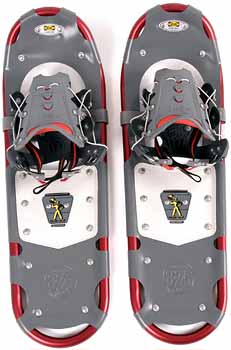
|
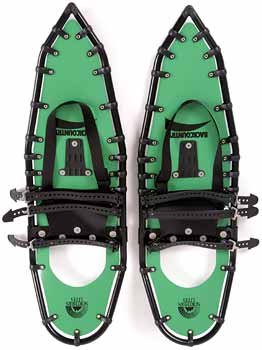
|
| (Left) The Atlas snowshoe 8 series is designed for moderate to steep terrain. The 30-inch model, $179, supports 170 to 250 pounds. (Right) The Northern Lites Backcountry, $229, supports 175 to 250 pounds and uses spacecraft aluminum frames. | |
Traditional wood and leather
Not everyone prefers high-tech materials. Traditional snowshoes are made of wood and leather. Iverson, a company from Michigan's wintry Upper Peninsula, offers several models, including the SnowMate (for children and teens) and the popular Modified Bearpaw for adults. Sold separately are harnesses and bindings (neoprene or rawhide contraptions that attach the snowshoe to your boot) and crampons (which provide traction on ice). (www.iversonsnowshoe.com)
Most manufacturers, however, use standard lightweight aluminum for the frames and synthetics for the harness and bindings. Snowshoe styles are grouped by function, depending on whether you plan to backpack, hike, or race.
A leader in the field is Tubbs, whose Discovery line is an excellent choice for children, teens, and first-timers. This moderately priced snowshoe is available in a starter kit ($189) that includes shoes, poles, and an instructional CD.
Tubbs's Pinnacle series is the top of the line in sophistication, flotation, and price. It is designed for more advanced terrain and can hold users up to 300 pounds. (www.tubbssnowshoes.com)
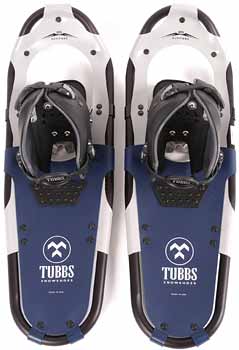 |
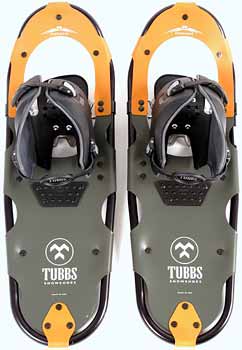
|
| (Left) The Tubbs 25-inch Altitude series supports 120 to 200 pounds and costs $229. (Right) The 25-inch Pinnacle series is designed for day hikers covering moderate to steep terrain and costs $249. | |
Bindings, boots, and poles
Most snowshoes come with built-in bindings, which attach the snowshoe to your boot. It takes some practice to fasten the bindings securely, if you use lace-ups. Step-in, ski-boot-style bindings are also available.
You can wear almost any kind of boots, including Maine-style hunting boots (also called shoepacs), backpacking boots, or insulated mountaineering boots. Try them on with the snowshoe in the store. Not all bindings will fit all boots. You'll also need a pair of gaiters to keep snow from entering your boots.
A pair of ski poles is a must: You will need them to keep your balance—and to help crawl out of the snow if you lose your balance.
Techniques for walking
Despite their clunky appearance, snowshoes actually allow you to walk in a normal gait. The only thing you can't do is walk backward, because the heel will stick in the snow and flip you over. To reverse direction, pivot the fronts of the snowshoes around in a circle.
For your first couple of excursions, stick to fairly flat terrain. Once you've mastered that, you can start on hills. It's easier to go straight up and straight down rather than sideways. The little crampons will grip the icy spots.
It won't take long for you to become confident in your snowshoeing skills. Soon you'll be taking every opportunity to explore the winter wilderness instead of staying cooped up inside with cabin fever.
Karen Berger is the author of nine books on outdoor adventure, including More Everyday Wisdom (Mountaineers Books). Visit her at www.hikerwriter.com.
January - February 2004 Table of Contents
Copyright © 2004 by the Boy Scouts of America. All rights thereunder reserved; anything appearing in Scouting magazine or on its Web site may not be reprinted either wholly or in part without written permission. Because of freedom given authors, opinions may not reflect official concurrence.